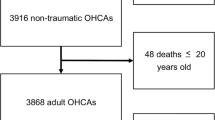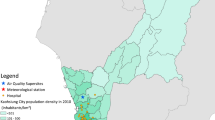Abstract
Limited evidence exists concerning the impact of particulate pollution on acute respiratory distress syndrome (ARDS). We examined the effects of particulate pollution on emergency ambulance dispatches (EAD) for ARDS in Guangzhou, China. Daily air pollution concentrations for PM10, PM2.5, and PM1, as well as PM2.5 chemical compositions, were available from a central air monitoring station. The association between incident ARDS and air pollution on the concurrent and previous 5 days was estimated by an over-dispersed Poisson generalized additive model controlling for meteorological factors, temporal trends, public holidays and day of the week. We identified a total of 17,002 EADs for ARDS during the study period. There were significant associations between concentrations of PM10, PM2.5, PM1, and ARDS; corresponding excess risk (ER) for an interquartile range IQR increase in 1-day lagged concentration was 5.45% [95% confidence interval (CI): 1.70%, 9.33%] for PM10 (45.4 μg/m3), 4.71% (95% CI: 1.09%, 8.46%) for PM2.5 (31.5 μg/m3), and 4.45% (95% CI: 0.81%, 8.23%) for PM1 (28.8 μg/m3), respectively. For PM2.5 chemical compositions, we found that OC, EC, sulfate and ammonium were significantly associated with ARDS. The observed effects remained even after adjusting for potentially confounding factors. This study suggests that PM10, PM2.5, and PM1, as well as chemical constituents from combustion and secondary aerosols might be important triggers of ARDS in Guangzhou.
This is a preview of subscription content, access via your institution
Access options
Subscribe to this journal
Receive 6 print issues and online access
$259.00 per year
only $43.17 per issue
Buy this article
- Purchase on Springer Link
- Instant access to full article PDF
Prices may be subject to local taxes which are calculated during checkout



Similar content being viewed by others
References
Qian Z, Lin HM, Stewart WF, Kong L, Xu F, Zhou D, Zhu Z, Liang S, Chen W, Shah N. Seasonal pattern of the acute mortality effects of air pollution. J Air Waste Manag Assoc. 2010;60:481–8.
Pope CA, Turner MC, Burnett RT, Jerrett M, Gapstur SM, Diver WR, Krewski D, Brook RD. Relationships between fine particulate air pollution, cardiometabolic disorders, and cardiovascular mortality. Circ Res. 2015;116:108–15.
Li P, Xin J, Wang Y, Wang S, Li G, Pan X, Liu Z, Wang L. The acute effects of fine particles on respiratory mortality and morbidity in Beijing, 2004–9. Environ Sci Pollut Res. 2013;20:6433–44.
Utell MJ, Frampton MW. Acute health effects of ambient air pollution: the ultrafine particle hypothesis. J Aerosol Med. 2000;13:355–9.
National Research Council: Committee on Research Priorities for Airborne Particulate Matter. Research Priorities for Airborne Particulate Matter, IV: Continuing Research Progress. Washington, DC: National Academies Press 2004.
Peters A, Wichmann HE, Tuch T, Heinrich J, Heyder J. Respiratory effects are associated with the number of ultrafine particles. Am J Respir Crit Care Med. 1997;155:1376–83.
Penttinen P, Timonen K, Tiittanen P, Mirme A, Ruuskanen J, Pekkanen J. Ultrafine particles in urban air and respiratory health among adult asthmatics. Eur Respir J. 2001;17:428–35.
Iskandar A, Andersen ZJ, Bonnelykke K, Ellermann T, Andersen KK, Bisgaard H. Coarse and fine particles but not ultrafine particles in urban air trigger hospital admission for asthma in children. Thorax. 2012;67:252–7.
Pun VC, Yu ITs HoK, Qiu H, Sun Z, Tian L. Differential effects of source-specific particulate matter on emergency hospitalizations for ischemic heart disease in Hong Kong. Environ Health Perspect. 2014;122:391–6.
Lin H, Tao J, Du Y, Liu T, Qian Z, Tian L, Di Q, Zeng W, Xiao J, Guo L, et al. Differentiating the effects of characteristics of PM pollution on mortality from ischemic and hemorrhagic strokes. Int J Hyg Environ Health. 2016;219:204–11.
Dominici F, Peng RD, Ebisu K, Zeger SL, Samet JM, Bell ML. Does the effect of PM10 on mortality depend on PM nickel and vanadium content? A reanalysis of the NMMAPS data. Environ Health Perspect. 2007;115:1701.
Peng RD, Bell ML, Geyh AS, McDermott A, Zeger SL, Samet JM, Dominici F. Emergency admissions for cardiovascular and respiratory diseases and the chemical composition of fine particle air pollution. Environ Health Perspect. 2009;117:957–63.
Steenhof M, Janssen NA, Strak M, Hoek G, Gosens I, Mudway IS, Kelly FJ, Harrison RM, Pieters RH, Cassee FR. Air pollution exposure affects circulating white blood cell counts in healthy subjects: the role of particle composition, oxidative potential and gaseous pollutants–the RAPTES project. Inhal Toxicol. 2014;26:141–65.
Dai L, Zanobetti A, Koutrakis P, Schwartz JD. Associations of fine particulate matter species with mortality in the United States: a multicity time-series analysis. Environ Health Perspect. 2014;122:837–42.
Walkey AJ, Summer R, Ho V, Alkana P. Acute respiratory distress syndrome: epidemiology and management approaches. Clin Epidemiol. 2012;4:159.
Lin H, Zhang Y, Xu Y, Xu X, Liu T, Luo Y, Xiao J, Wu W, Ma W. Temperature changes between neighboring days and mortality in summer: a distributed lag non-linear time series analysis. PLoS ONE. 2013;8:e66403.
Jahn HJ, Schneider A, Breitner S, Eißner R, Wendisch M, Krämer A. Particulate matter pollution in the megacities of the Pearl River Delta, China–A systematic literature review and health risk assessment. Int J Hyg Environ Health. 2011;214:281–95.
Yu ITS, Zhang YH, San Tam WW, Yan QH, Xu YJ, Xun XJ, Wu W, Ma WJ, Tian LW, Tse LA, et al. Effect of ambient air pollution on daily mortality rates in Guangzhou, China. Atmos Environ. 2012;46:528–35.
Yang C, Chen A, Chen R, Qi Y, Ye J, Li S, Li W, Liang Z, Liang Q, Guo D, et al. Acute effect of ambient air pollution on heart failure in Guangzhou, China. Int J Cardiol. 2014;177:436–41.
Lin H, Tao J, Du Y, Liu T, Qian Z, Tian L, Di Q, Rutherford S, Guo L, Zeng W. et al. Particle size and chemical constituents of ambient particulate pollution associated with cardiovascular mortality in Guangzhou, China. Environ Pollut. 2016;208(Part B):758–66.
Tao J, Shen Z, Zhu C, Yue J, Cao J, Liu S, Zhu L, Zhang R. Seasonal variations and chemical characteristics of sub-micrometer particles (PM1) in Guangzhou, China. Atmos Res. 2012;118:222–31.
Tao J, Zhang L, Ho K, Zhang R, Lin Z, Zhang Z, Lin M, Cao J, Liu S, Wang G. Impact of PM2.5 chemical compositions on aerosol light scattering in Guangzhou — the largest megacity in South China. Atmos Res. 2014;135–6:48–58.
Stieb DM, Szyszkowicz M, Rowe BH, Leech JA. Air pollution and emergency department visits for cardiac and respiratory conditions: a multi-city time-series analysis. Environ Health. 2009;8:25.
Zanobetti A, Schwartz J. Mortality displacement in the association of ozone with mortality. Am J Respir Crit Care Med. 2008;177:184–9.
Peng RD, Dominici F, Louis TA. Model choice in time series studies of air pollution and mortality. J Roy Stat Soc Ser A. 2006;169:179–203.
Curriero FC, Heiner KS, Samet JM, Zeger SL, Strug L, Patz JA. Temperature and mortality in 11 cities of the eastern United States. Am J Epidemiol. 2002;155:80–7.
Peng RD, Samoli E, Pham L, Dominici F, Touloumi G, Ramsay T, Burnett RT, Krewski D, Le Tertre A, Cohen A. Acute effects of ambient ozone on mortality in Europe and North America: results from the APHENA study. Air Quality, Atmosphere Health 2012;6:445–453.
Kan H, London SJ, Chen G, Zhang Y, Song G, Zhao N, Jiang L, Chen B. Differentiating the effects of fine and coarse particles on daily mortality in Shanghai, China. Environ Int. 2007;33:376–84.
Son JY, Lee JT, Kim KH, Jung K, Bell ML. Characterization of fine particulate matter and associations between particulate chemical constituents and mortality in Seoul, Korea. Environ Health Perspect. 2012;120:872.
Yang C, Peng X, Huang W, Chen R, Xu Z, Chen B, Kan H. A time-stratified case-crossover study of fine particulate matter air pollution and mortality in Guangzhou, China. Int Arch Occup Environ Health. 2012;85:579–85.
Ostro B, Feng WY, Broadwin R, Green S, Lipsett M. The effects of components of fine particulate air pollution on mortality in California: results from CALFINE. Environ Health Perspect. 2007;115:13–9.
Cao J, Xu H, Xu Q, Chen B, Kan H. Fine particulate matter constituents and cardiopulmonary mortality in a heavily polluted Chinese City. Environ Health Perspect. 2012;120:373–8.
Qiao L, Cai J, Wang H, Wang W, Zhou M, Lou S, Chen R, Dai H, Chen C, Kan H. PM2.5 Constituents and hospital emergency-room visits in Shanghai, China. Environ Sci Technol. 2014;48:10406–14.
Zhang J, Zhu T, Kipen H, Wang G, Huang W, Rich D, Zhu P, Wang Y, Lu S, Ohman Strickland P. Cardiorespiratory biomarker responses in healthy young adults to drastic air quality changes surrounding the 2008 Beijing Olympics. Research report (Health Effects Institute) 2013;174:5–174.
Mar TF, Norris GA, Koenig JQ, Larson TV. Associations between air pollution and mortality in Phoenix, 1995–7. Environ Health Perspect. 2000;108:347–53.
Dockery DW, Stone PH. Cardiovascular risks from fine particulate air pollution. N Engl J Med. 2007;356:511–3.
Selgrade MK. Air pollution and respiratory disease: extrapolating from animal models to human health effects. Immunopharmacology. 2000;48:319–24.
Rich DQ, Kipen HM, Huang W, Wang G, Wang Y, Zhu P, Ohman Strickland P, Hu M, Philipp C, Diehl SR. Association between changes in air pollution levels during the Beijing Olympics and biomarkers of inflammation and thrombosis in healthy young adults. JAMA. 2012;307:2068–78.
Oberdorster G. Pulmonary effects of inhaled ultrafine particles. Int Arch Occup Environ Health. 2000;74:1–8.
Brook RD, Franklin B, Cascio W, Hong Y, Howard G, Lipsett M, Luepker R, Mittleman M, Samet J, Smith SC. Air pollution and cardiovascular disease: a statement for healthcare professionals from the expert panel on population and prevention science of the American Heart Association. Circulation. 2004;109:2655–71.
Tao Y, Mi S, Zhou S, Wang S, Xie X. Air pollution and hospital admissions for respiratory diseases in Lanzhou, China. Environ Pollut. 2014;185:196–201.
Acknowledgements
The study was supported by the Public Welfare Research Program of National Health and Family Planning Commission of China (201502003, 201402022), Guangdong Department of Science and Technology, China (2015A020215037), and the Natural Science Foundation of Guangdong Province, China (2014A030310077).
Author information
Authors and Affiliations
Corresponding authors
Ethics declarations
Conflict of interest
The authors declare that they have no conflict of interest.
Electronic supplementary material
Rights and permissions
About this article
Cite this article
Lin, H., Tao, J., Kan, H. et al. Ambient particulate matter air pollution associated with acute respiratory distress syndrome in Guangzhou, China. J Expo Sci Environ Epidemiol 28, 392–399 (2018). https://doi.org/10.1038/s41370-018-0034-0
Received:
Revised:
Accepted:
Published:
Issue Date:
DOI: https://doi.org/10.1038/s41370-018-0034-0
Keywords
This article is cited by
-
Effects of ambient air pollutants on ARDS incidence and outcome: a narrative review
Annals of Intensive Care (2023)
-
Exposure to ambient air pollutants and acute respiratory distress syndrome risk in sepsis
Intensive Care Medicine (2023)
-
Do air pollutants as well as meteorological factors impact Corona Virus Disease 2019 (COVID-19)? Evidence from China based on the geographical perspective
Environmental Science and Pollution Research (2021)
-
Impact of air quality on students’ behavior in the Educational Centers
Air Quality, Atmosphere & Health (2021)
-
Personal exposure to PM2.5-bound heavy metals associated with cardiopulmonary function in general population
Environmental Science and Pollution Research (2021)



